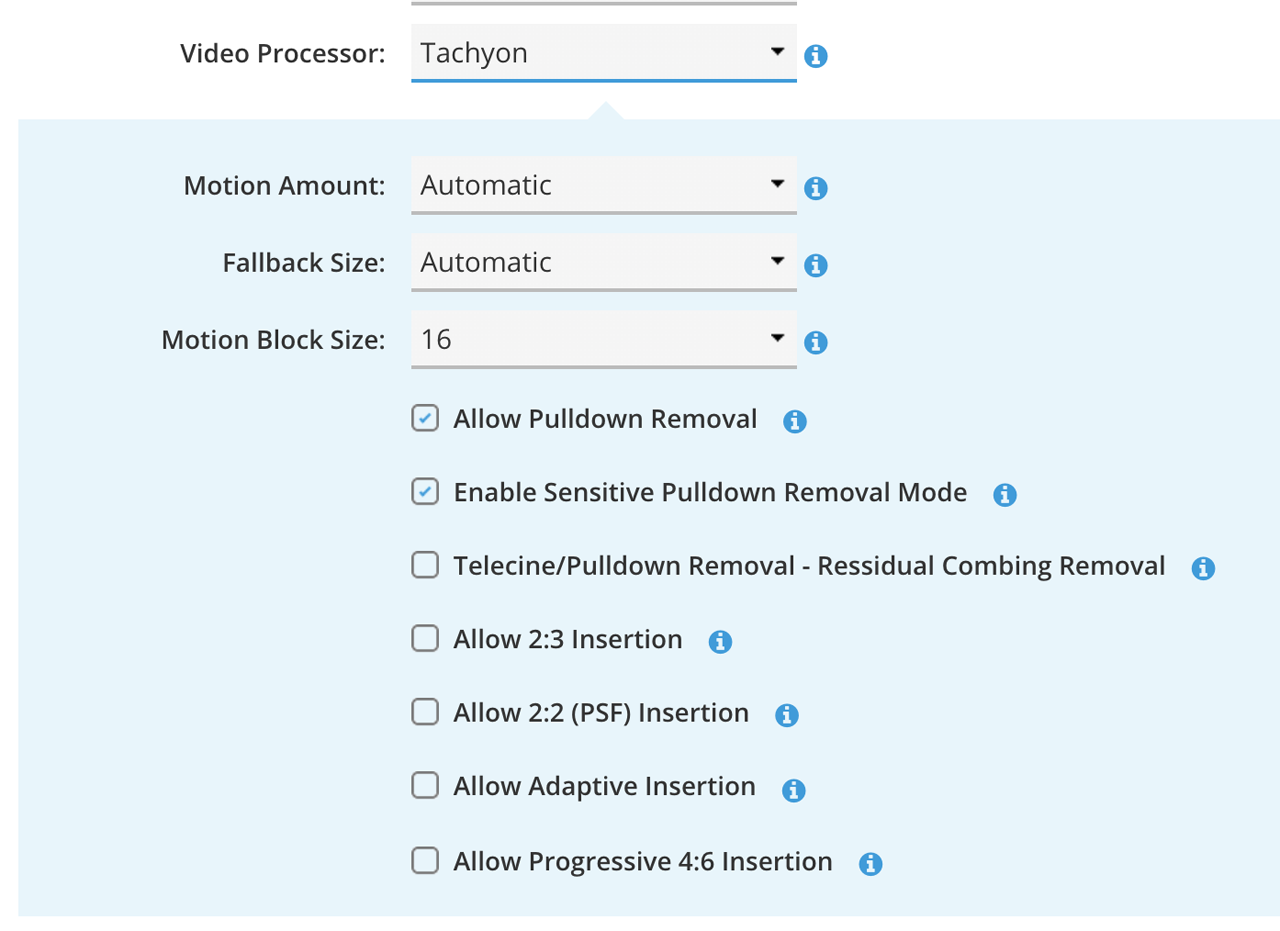Tachyon standards conversion guidelines
Cinnafilm Tachyon overview and recommended settings guide for various conversion types
Any professional who deals in mixed broadcasting standards and formats is aware that converting between a different numbers of pixels and different frame rates in video is a complex technical problem. However, the international exchange of TV programming makes standards conversion necessary and unavoidable.
Tachyon from Cinnafilm is widely recognized as one of the best tools for such tasks. It's based on their phase correlation motion estimation engine that performs analysis on each frame, mapping the velocity and direction of each individual pixel. That motion information is used to predict (or synthesize) new frames at any point in time, to deliver smooth motion playback at any frame rate.
Tachyon's applications include:
- frame rate conversion to and from all standard frame rates (from 23.976 up to 59.94), resolutions, aspect ratios, interlaced and progressive
- automatic 3:2 pulldown/telecine removal with advanced cadence correction capable of resolving broken phase errors and issues with transitions between progressive, pulldown, and standard interlaced material
- highest quality motion-compensated de-interlacing to preserve the maximum detail
- resolution conversion to and from any resolution up to 4K
- insertion of common pulldown patterns: 2:3, 2:2 PsF, and frame repeat to preserve film motion when targeting high progressive frame rates
Tachyon settings are available in Profile Settings in the Video tab.

Tachyon configuration in profile settings
The amount of motion data present in the source file is critical to the outcome of motion compensation technologies:
- Starting with lower progressive frame rates will provide the least amount of motion data and will require higher amounts of fallback. The potential to create artifacts is highest when starting with low progressive frame rates (23.976, 24, 25, 29.97, 30).
- Starting with higher progressive frame essence rates will provide the cleanest conversions and will require less fallback. (25i, 29.97i, 50p, 59.94p are examples of higher frame rates which will create conversions with lower potential for artifacts.)
- When placed in AUTO, Tachyon will automatically adjust the motion compensation block size, fallback amount, motion amount, and block size on a scene by scene basis. However, manual override is possible by unchecking auto and selecting the settings desired.
In most cases when motion compensation is applied it's recommended to rely on the Tachyon Auto settings for:
- Motion Compensation Amount - controls amount of motion compensation applied depending on the scene dynamics
- Motion Compensation Block Size - frames are partitioned into blocks which together with the motion vector are used to predict frames, larger blocks reduce the amount of computation but can result in poor prediction, depending on amount of motion in the scene Tachyon will adjust the block size to account for that
- Motion Compensation Fallback Blend Area - size of the transition region between motion compensated areas and fallback areas where algorithms are applied to prevent artifacts
These should yield optimal results in 90% of cases. You may want to change these settings when performing specific types of conversions like Inverse Telecine (bringing back typical 24fps film framerate from NTSC's 29.97fps). Motion compensation is not necessary here, but there are dedicated extra settings for this conversion that could improve the quality:
- Allow Pulldown Removal will remove simple 3:2 pulldown patterns, automatically detect when Telecine patterns (cadence) is broken as well as advanced cadence patterns such as the common 2224 pattern
- Enable Sensitive Pulldown Removal Mode - lowers threshold when sensing pulldown frames, useful in case of broken cadence or other factors like highly mixed content or if chroma noise masks motion
- Telecine/Pulldown Removal - Residual Combing Removal - applies de-interlacer to frames to get rid of combing artifacts if they exist after pulldown has been removed (may slightly degrade vertical resolution)
Cinnafilm provides and interactive guide with suggested settings for each type of conversion: https://cinnafilm.com/tachyon-settings-guide/
Updated over 3 years ago
